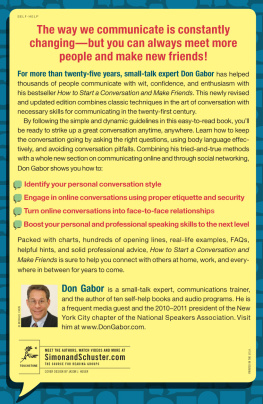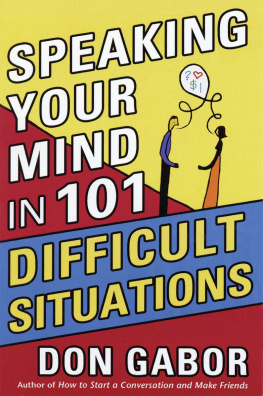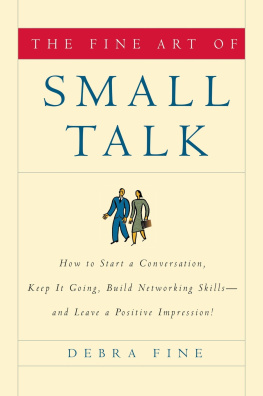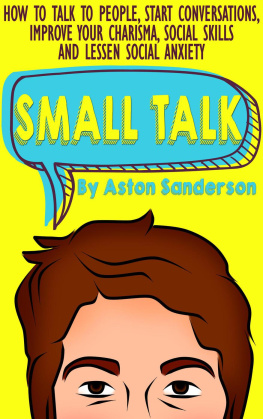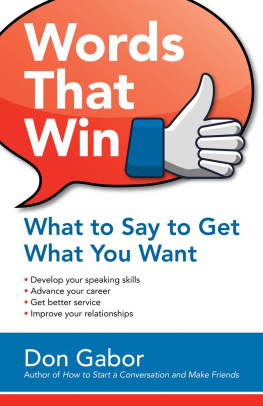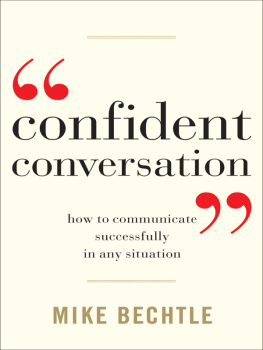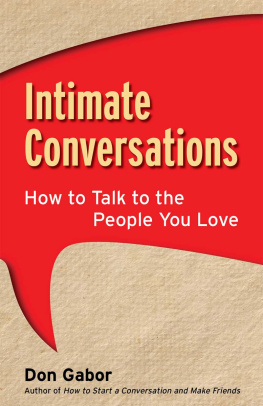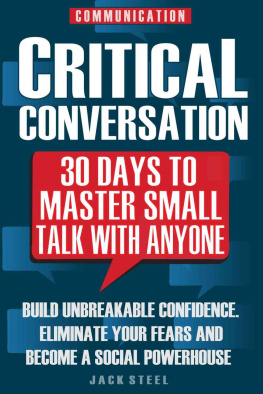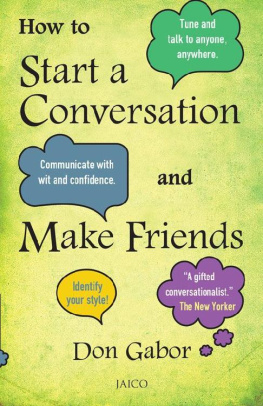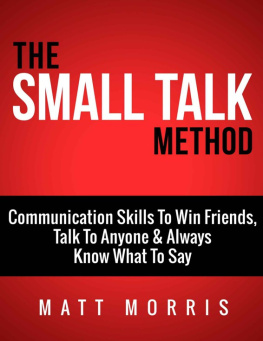
A LSO BY D ON G ABOR
Books
Big Things Happen When You Do the Little Things Right
How to Talk to the People You Love
Speaking Your Mind in 101 Difficult Situations
Talking with Confidence for the Painfully Shy
Turn Small Talk into Big Deals
Words That Win: What to Say to Get What You Want
Audiobooks
Cmo Iniciar una Conversacin
How to Start a Conversation and Make Friends
Talking with Confidence for the Painfully Shy


| Touchstone
A Division of Simon & Schuster, Inc.
1230 Avenue of the Americas
New York, NY 10020
www.SimonandSchuster.com |
Copyright 1983, 2001, 2011 by Don Gabor
All rights reserved, including the right to reproduce this book or portions thereof in any form whatsoever. For information, address Fireside Subsidiary Rights Department, 1230 Avenue of the Americas, New York, NY 10020.
First Touchstone trade paperback edition June 2011
TOUCHSTONE and colophon are registered trademarks of Simon & Schuster, Inc.
The Simon & Schuster Speakers Bureau can bring authors to your live event. For more information or to book an event, contact the Simon & Schuster Speakers Bureau at 866-248-3049 or visit our website at www.simonspeakers.com .
Manufactured in the United States of America
10 9 8 7 6 5 4 3 2 1
Library of Congress Cataloging-in-Publication Data
Gabor, Don.
How to start a conversation and make friends / by Don Gabor ; illustrated by Mary Power.[Rev. ed.].
p. cm.
A Touchstone book.
Includes index.
1. Conversation. 2. Friendship. I. Power, Mary. II. Title.
BJ2121.G3 2011
153.6dc22
2011008739
ISBN 978-1-4516-1099-4
eISBN 978-1-4516-1100-7
I dedicate this book to my parents, Trude and Fred, and my sister, Ellen.
Thank you for giving me the confidence and encouragement to talk to anyone, anyplace, about anything.
I also dedicate this book to my wife and the love of my life, Eileen.
Contents
Acknowledgments
My special thanks go to:
My wife, Eileen Cowell, for her loving and continued support, many excellent editorial suggestions, and more than twenty-five years of rewarding and insightful conversations.
My editors, Michelle Howry and Alessandra Preziosi, at Simon & Schuster for their enthusiasm, many useful ideas, and belief in this project.
My agent, Herb Schaffner, for helping me bring this project to Simon & Schuster and all his efforts on my behalf.
Jeffrey Hollender for the original opportunity to develop my conversation course in 1980 and the first edition of this book in 1983.
A Note from the Author
How to Start a Conversation and Make Friends was first published in 1983 and revised in 2001. Since then, I have written several books and presented many workshops on conversation skills to people all over the country. Still, even after all my years of teaching, writing, and talking about this subject, I realize there is always something to learn about the art of conversation.
The revisions in this book are based on feedback and questions from hundreds of readers and students, plus additional research and personal experience. I have reorganized the book into four parts: Starting Your Conversations with Confidence; Continuing and Ending Your Conversations with Charm, Confidence, and Tact; Navigating Online Networks to Expand Your Business, Social, and Personal Relationships; and Boosting Your Conversations to the Next Level.
Included in these sections are new and revised chapters on body language; knowing what to say after you say hello; telling others about yourself; remembering names; dealing with awkward conversations; exploring social networks; making contacts and friends online; networking; starting and rekindling friendships; dating; conversation styles; talking to people from other countries; plus a final list of 60 ways to improve your conversations and build lasting friendships. There are also many frequently asked questions (FAQs) throughout the text.
Most people want and need human contact, and that connection often takes the form of a simple conversation. The secret to starting conversations and making friends rests on four key principles: (1) taking the initiative to reach out to others; (2) showing genuine interest in people; (3) treating others with respect and kindness; and (4) valuing others and yourself as unique individuals who have much to share and offer one another. When you apply these ideas and the many other skills and tips in this book, you can become a great conversationalist. I hope that this newly revised edition will help you achieve this goal.
Introduction: Meeting New People and Making New FriendsIts What Todays Success Is All About!
Good conversation is what makes us interesting. After all, we spend a great deal of our time talking and a great deal of our time listening. Why be bored, why be boringwhen you dont have to be either?
Edwin Newman (19192010), news commentator
T he next time you walk into a room full of people, just listen to them talking! Theyre all communicating through conversation. Conversation is our main way of expressing our ideas, opinions, goals, and feelings to those we come into contact with. It is also the primary means of beginning and establishing friendships and relationships.
Open Your Conversation Channel in Person and Online via Social Networks
Whether we meet people at parties, at work, or on social networking sites like Facebook or LinkedIn, we can connect and communicate with those people when the channel of conversation is open. If the channel is closed, then starting and sustaining a conversation and creating a relationship of any kind is next to impossible.
This book is based on my more than thirty years teaching and writing about how to start a conversation and make friends. It will show you how to open your conversational channel and tune in to the people you meet in your daily activities and online through social networks. The conversational techniques in this book have been successfully tested in my workshops and proven as methods of starting and sustaining conversations in nearly every situationincluding social and business settings.
The techniques are presented in an easy-to-master format so you can start improving your communication skills and self-confidence quickly. Hundreds of examples demonstrate what you can say in real-life situations so you can practice and adapt them within the context of your own lifestyle and at your own pace.
This book can be helpful to anyone who wants to communicate better at home, at work, online, or anywhere in between, including:
Business executives, managers, and new hires
Members of Facebook, LinkedIn, and other social networks
Consultants and sales representatives
Singles and couples
Computer programmers and other technical professionals
Entrepreneurs and freelancers
English language learners
Career counselors and life coaches
Psychologists, therapists, and clients
Students and teachers
Parents and teenagers
If you want more rewarding conversations in professional, social, or personal situations, then this book is for you.
Next page
